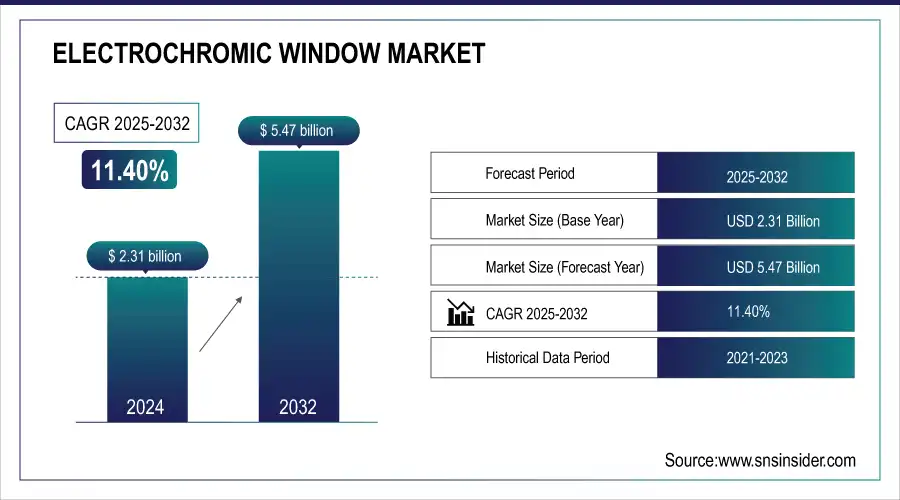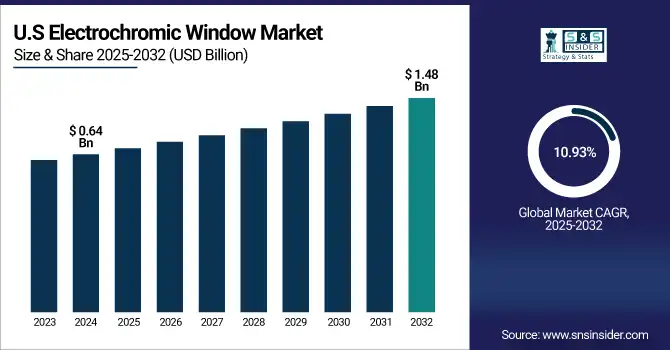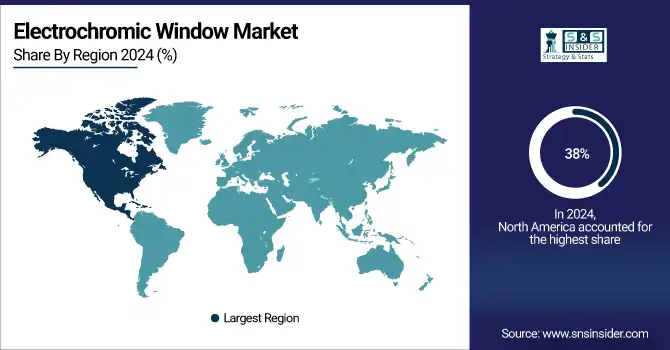Electrochromic Window Market Report Scope & Overview:
The Electrochromic Window Market was valued at USD 2.31 billion in 2024 and is expected to reach USD 5.47 billion by 2032, growing at a CAGR of 11.40% from 2025-2032.

To get more information on Electrochromic Window Market - Request Free Sample Report
This report provides a comprehensive analysis of the Electrochromic Window Market, focusing on technology and innovation, highlighting advancements in SPD and PDLC technologies that enhance dynamic glass functionality. It explores energy savings and efficiency metrics, demonstrating the potential of electrochromic windows to reduce energy consumption in commercial buildings. The impact of government incentives and regulations is also covered, with policies in various regions driving adoption through tax credits and energy efficiency mandates. Additionally, the report presents export/import data, revealing a growing export trend from established markets to emerging regions. Other emerging trends include the integration of smart home systems and sustainability efforts, positioning electrochromic windows as a key component of future urban infrastructure.
Electrochromic Window Market Size and Forecast
-
Electrochromic Window Market Size in 2024: USD 2.31 Billion
-
Electrochromic Window Market Size by 2032: USD 5.47 Billion
-
CAGR: 11.49% from 2025 to 2032
-
Base Year: 2024
-
Forecast Period: 2025–2032
-
Historical Data: 2021–2023
Electrochromic Window Market Trends
-
Rising demand for energy-efficient buildings and smart infrastructure is driving electrochromic window adoption.
-
Increasing focus on sustainability and green building certifications is boosting market growth.
-
Integration with IoT and smart home systems is enhancing automated light and heat control.
-
Growing use in commercial buildings, residential spaces, and transportation (automotive & aviation) is widening applications.
-
Advancements in electrochromic materials are improving durability, response time, and cost-effectiveness.
-
Adoption of smart glass in premium automobiles and luxury real estate is accelerating demand.
-
Collaborations between glass manufacturers, construction firms, and tech providers are fostering innovation and large-scale deployment.
U.S. Electrochromic Window Market was valued at USD 0.64 billion in 2024 and is expected to reach USD 1.48 billion by 2032, growing at a CAGR of 10.93% from 2025-2032.
The U.S. Electrochromic Window Market is growing due to increasing demand for energy-efficient buildings, smart glass adoption, rising awareness of sustainable construction, government incentives, and technological advancements in electrochromic materials.

Electrochromic Window Market Growth Drivers:
-
The growing demand for energy-efficient buildings and stringent regulations are driving the adoption of electrochromic windows to reduce HVAC costs and enhance sustainability.
The electrochromic window market is witnessing significant growth due to the rising demand for energy-efficient solutions in commercial and residential buildings. As more people become aware of the importance of saving energy and building efficiency, laws are getting stricter, and electrochromic technology is attracting attention as a greener alternative to conventional glazing. These smart windows change tint automatically as per the external conditions, which reduces the dependency on HVAC systems, thus saving energy consumption. It is also aided by green building certifications, governmental incentives, and the increasing popularity of smart home technologies. The continuous increase in electrochromic windows integration in Internet of Things (IoT) enabled smart building automation systems also makes them appealing among home builders by promoting energy management. Ongoing material science developments also promise to rapidly enhance the switching speeds, lifetimes, and cost-efficacy of such optical windows. With the construction industry increasingly emphasizing sustainability, the electrochromic window market will undergo strong growth in the upcoming years.
Electrochromic Window Market Restraints:
-
The high initial cost of electrochromic windows, driven by advanced materials and installation expenses, limits adoption in cost-sensitive markets.
The high initial cost of electrochromic windows remains a significant barrier to widespread adoption, particularly in price-sensitive markets. Compared to traditional glass, electrochromic windows use sophisticated materials, including unique coatings and multilayer structures, making them more costly to manufacture. Furthermore, other costs are introduced with the incorporation of electric control systems and smart sensors. Installation is also costlier since these windows usually involve professional installation and specialised wiring. Though the long-term energy savings and efficiency gains can outweigh the upfront costs, many consumers and businesses are reluctant due to the high initial investment. This particular challenge has been observed predominantly in the residential and small commercial sectors, where buyers are most likely to consider cheaper alternatives. Additionally, the relatively small scale of production compared to traditional windows keeps prices elevated. Hence, we expect technological advancements and economies of scale within a few years to reduce costs and make way in the market.
Electrochromic Window Market Opportunities:
-
Advancements in material science are driving the electrochromic window market by enabling faster switching times, improved durability, and enhanced energy efficiency.
Advancements in material science are playing a crucial role in accelerating the growth of the electrochromic window market. New electrochromic materials are being developed that respond faster, allowing windows to switch more rapidly between tinted and clear states. With these improvements, the user experience is enhanced as the waiting period for windows to adjust is greatly reduced, allowing for normal usage in real life. More than that, these novel materials also improve the functioning of electrochromic windows in terms of color uniformity, durability, and energy efficiency. For instance, the invention of new nanomaterials and composite coatings could prolong the life of electrochromic windows without altering their optical and electrical properties. The increased availability and affordability of these materials are likely to drive demand for electrochromic windows, especially in industries such as construction, automotive, and aerospace, where energy efficiency and smart technologies are priorities.
Electrochromic Window Market Challenges:
-
End-users often hesitate to invest in electrochromic windows due to the high initial costs and uncertainty about the long-term energy savings and payback period compared to traditional glazing solutions.
One of the key challenges hindering the adoption of electrochromic windows is the concern over return on investment (ROI). Especially in the commercial and residential sectors, end-users remain reluctant to invest in electrochromic windows due to concerns regarding long-term benefits and payback periods. Though electrochromic windows are energy-efficient since they help reduce reliance on cooling and heating systems that consume power, their installation costs are much higher than traditional glazing solutions. The elevated cost, along with a predictable long payback, particularly for small jobs, can put off would-be purchasers. It can also be difficult to pinpoint the exact payback period, which depends on factors such as building size, climate, and energy usage patterns. Without a clear, measurable saving over time, the vast majority of customers are not picking this technology and using the cheaper alternatives with more predictable financial returns in the short term.
Electrochromic Window Market Segmentation Analysis
By Application, Residential dominates the electrochromic window market, Commercial is expected to grow fastest.
The residential segment is dominated with a market share of over 32% in 2023, due to the increasing demand for energy-efficient and smart home technologies. One of the biggest advantages of electrochromic windows is that they control the entry of heat and light, reducing energy consumption. For that reason, these windows are beneficial for thermal insulation, and in turn, less reliance on artificial heating or refrigeration, which ultimately leads to cheaper energy expenses. Anti-glare systems using thin polymers are a solution to combat the continuity of the mutual heat generation that the greenhouse effect creates. This trend is likely to continue, with energy-efficient home renovations seeing a sharp increase in interest and affordability for homeowners, thus continuing to make the residential segment the most dominant and powerful in the market.
By Technology, Electrochromic Glass dominates the market, Polymer Dispersed Liquid Crystal (PDLC) is expected to grow fastest.
The Electrochromic Glass segment is dominated with a market share of over 54% in 2023. It is popular because of its dynamic tinting ability, where the tint changes when an electrical signal is applied, providing energy savings through controlled solar heat gain and light transmission. This additional feature provides energy-efficient working modules in buildings, reducing the need for artificial heating or cooling. In addition, electrochromic devices also enhance occupant comfort by reducing glare and blocking the line of sight; consequently, these properties make them a preferable choice for commercial and residential buildings. The saturation of the market with the high-quality content of electrochromic glass and some new developments, extending its demand across multilayer industries such as architecture, automobile, aerospace sector, etc.

By End-Use, Buildings dominate the market, Automotive is expected to grow fastest
The Buildings segment dominated with a market share of over 38% in 2023, largely driven by the growing emphasis on energy efficiency and sustainability in both residential and commercial sectors. Electrochromic windows allow the window to darken in response to an electrical voltage, providing energy consumption optimization and improving indoor comfort through glare and heat control with natural light. These windows are especially desirable for their potential to improve building energy performance and curtail consumption of artificial heating and cooling. Smart glass technologies, such as electrochromic window adoption, grow even as energy efficiency regulations tighten. Moreover, their aesthetic value and ability to enhance the appearance of buildings are other factors that lead to their extensive utilization in contemporary construction designs.
By Product Type, Self-dimming windows are the fastest-growing segment in the electrochromic window market, Fixed-tint windows dominate in basic adoption
The Self-dimming windows are a rapidly growing segment in the electrochromic window market, offering a significant share due to their energy efficiency and convenience. These windows adjust their opacity automatically based on the intensity of the sunlight, minimizing glare and heat and maximizing natural light. This dynamic regulation makes it possible to keep indoor temperatures comfortable while minimizing the use of artificial lighting and HVAC systems, which leads to energy savings. Self-dimming windows are becoming increasingly in demand in automotive, residential, and commercial buildings, where they serve both functional and aesthetic purposes. With the ability to offer privacy, reduce UV exposure, and increase energy efficiency, they become increasingly appealing for sustainable construction and smart buildings, further increasing demand in many applications.
Electrochromic Window Market Regional Analysis
North America Electrochromic Window Market Insights
The North America region dominated with a market share of over 38% in 2024, driven by its advanced infrastructure and widespread adoption of smart window technologies. Strong emphasis on energy efficiency in the region, backed by government incentives and regulations, is one of the key factors that have led to a major increase in the uptake of electrochromic windows. Dynamic windows are particularly popular in commercial as well as residential buildings, as they automatically tint to control solar heat gain. Their energy-saving potential helps reduce heating and cooling expenses, making them an appealing option for eco-friendly consumers and organizations. The adoption of electrochromic windows is also increasing in North America due to the region's emphasis on sustainability and reducing carbon footprints.

Need any customization research on Electrochromic Window Market - Enquiry Now
Asia Pacific Electrochromic Window Market Insights
The Asia-Pacific region is the fastest-growing market for electrochromic windows, driven by several factors. The demand for construction is driven primarily by exploding urbanization, rising disposable incomes, and a middle class in countries such as China, Japan, and India. Also, strong emphasis on energy efficiency and environmental sustainability in the region has driven the implementation of green building technologies such as electrochromic windows. The stringent energy efficiency regulations from the government for construction and the automotive sector are also adding to the market growth. With the expansion of the construction industry and tech integration for better energy efficiency, electrochromic windows provide one important option for energy-efficient smart buildings and electric vehicles looking to save power & improve comfort. These combined factors make the Asia-Pacific region a prominent player in the electrochromic window market.
Europe Electrochromic Window Market Insights
Europe holds a strong position in the Electrochromic Window Market, driven by sustainable construction practices, stringent energy-efficiency regulations, and growing smart building adoption. Increasing retrofitting projects in commercial spaces and demand for advanced glazing in automotive applications further strengthen market expansion. Supportive EU policies promoting green buildings and technological innovations by regional players continue to accelerate deployment, making Europe a key contributor to global electrochromic window adoption and growth.
Middle East & Africa and Latin America Electrochromic Window Market Insights
Middle East & Africa and Latin America are emerging markets for electrochromic windows, fueled by rising urbanization, infrastructure modernization, and demand for energy-efficient buildings. Hot climates in MEA drive adoption of smart glazing for heat control, while Latin America benefits from expanding commercial construction and sustainability initiatives. Increasing government focus on green building codes and growing awareness of smart glass technologies are expected to accelerate regional market growth in coming years.
Electrochromic Window Market Competitive Landscape:
Gentex Corporation
Gentex Corporation, founded in 1974 and headquartered in Michigan, USA, is a global leader in dimmable glass, automotive electronics, and smart vision technologies. The company specializes in electrochromic mirrors, windows, and advanced driver-assistance solutions, catering primarily to automotive, aerospace, and architectural industries. With strong R&D capabilities, Gentex continues to innovate in safety, comfort, and energy-efficient solutions, aligning with global sustainability and smart mobility trends.
-
In January 2025, Gentex unveiled its next-generation dimmable glass, vision, sensing, and connectivity solutions at CES 2025. Highlights included innovative sun visors, electrochromic sunroof glass, advanced driver monitoring systems, thermal imaging for nighttime pedestrian detection, and a wireless power transfer demonstrator.
Glaston Corporation
Glaston Corporation, established in 1870 and headquartered in Helsinki, Finland, is a leading provider of glass processing technologies and services. The company specializes in equipment for architectural, automotive, solar, and appliance glass, focusing on energy efficiency, safety, and smart functionalities. With expertise in tempering, laminating, and insulating solutions, Glaston supports high-performance glass production and has a global footprint across key markets, driving innovation in sustainable and dynamic glazing solutions.
-
In January 2025, Glaston and Miru Smart Technologies announced a collaboration to scale next-generation electrochromic windows. This partnership combines Glaston’s expertise in glass processing with Miru’s advanced window technology to enable cost-effective, high-volume manufacturing of dynamic eWindows, enhancing energy efficiency and production optimization.
Key players in the Electrochromic Window Market
-
AGC Inc. (Halio Smart Glass)
-
ChromoGenics AB, (ConverLight Dynamic Glass)
-
Compagnie de Saint-Gobain S.A. (SageGlass)
-
Hitachi Chemical Co. Ltd. (Electrochromic Film)
-
Kinestral Technologies Inc. (Halio Smart-Tinting Glass)
-
Pleotint LLC (Suntuitive Dynamic Glass)
-
Polytronix Inc (Polyvision Privacy Glass)
-
Research Frontiers Inc. (SPD-SmartGlass)
-
Smartglass International Ltd. (LC SmartGlass)
-
View Inc. (View Smart Windows)
-
Gentex Corporation (Gentex Auto-Dimming Windows)
-
Guardian Glass (SunGuard Electrochromic Glass)
-
Merck KGaA (Licrivision Smart Glass)
-
PPG Industries Inc. (Electrochromic Coatings)
-
Gauzy Ltd. (Laminated Smart Glass)
-
Vision Systems (Nuance V2 Smart Windows)
-
Fuyao Glass Industry Group (Automotive Smart Glass)
-
Cardinal Glass Industries (Dynamic Tinting Glass)
-
Schott AG (Privalite Switchable Glass)
-
RavenWindow (RavenWindow Smart Glass)
-
Glaston (Electrochromic Glass, solutions for manufacturing smart windows and dynamic glass products)
Suppliers for (Producing smart windows that tint in response to sunlight, reducing energy costs, and providing natural light control) Electrochromic Window Market
-
View Inc.
-
SageGlass (Saint-Gobain)
-
SPD Control System, Inc.
-
Research Frontiers Inc.
-
SmartGlass International
-
EControl-Glas
-
Glass Apps LLC
-
Polytronix, Inc.
-
Sonte, Inc.
-
Giantec Semiconductor
| Report Attributes | Details |
|---|---|
| Market Size in 2024 | USD 2.31 Billion |
| Market Size by 2032 | USD 5.47 Billion |
| CAGR | CAGR of 11.40% From 2025 to 2032 |
| Base Year | 2024 |
| Forecast Period | 2025-2032 |
| Historical Data | 2021-2023 |
| Report Scope & Coverage | Market Size, Segments Analysis, Competitive Landscape, Regional Analysis, DROC & SWOT Analysis, Forecast Outlook |
| Key Segments | • By Application (Residential, Commercial, Automotive, Aerospace, Marine) • By Technology (Electrochromic Glass, Electrochromic Films, Smart Tint) • By End Use (Buildings, Vehicles, Aircraft, Boats) • By Product Type (Passive Windows, Active Windows, Self-Dimming Windows) |
| Regional Analysis/Coverage | North America (US, Canada, Mexico), Europe (Eastern Europe [Poland, Romania, Hungary, Turkey, Rest of Eastern Europe] Western Europe] Germany, France, UK, Italy, Spain, Netherlands, Switzerland, Austria, Rest of Western Europe]), Asia Pacific (China, India, Japan, South Korea, Vietnam, Singapore, Australia, Rest of Asia Pacific), Middle East & Africa (Middle East [UAE, Egypt, Saudi Arabia, Qatar, Rest of Middle East], Africa [Nigeria, South Africa, Rest of Africa], Latin America (Brazil, Argentina, Colombia, Rest of Latin America) |
| Company Profiles | AGC Inc., ChromoGenics AB, Compagnie de Saint-Gobain S.A., Hitachi Chemical Co. Ltd., Kinestral Technologies Inc., Pleotint LLC, Polytronix Inc., Research Frontiers Inc., Smartglass International Ltd., View Inc., Gentex Corporation, Guardian Glass, Merck KGaA, PPG Industries Inc., Gauzy Ltd., Vision Systems, Fuyao Glass Industry Group, Cardinal Glass Industries, Schott AG, RavenWindow. |

